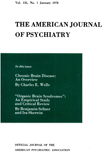EFFECTS OF SEDATIVE DRUGS ON THE ELECTROENCEPHALOGRAM
Abstract
A study is presented of the electroencephalographic effects of small oral doses of the usual sedative drugs (phenobarbital, sodium amytal, nembutal, seconal, paraldehyde, chloral) in 10 normal subjects with normal EEGs.
Data on 45 psychiatric patients who had received oral sedation within 24 hours of the electroencephalographic recording are compared with a control group of 45 psychiatric patients who had received no sedation. Patients with a diagnosis of epilepsy or of organic central nervous system disease were excluded from this study.
The results of the two methods of study are in essential agreement and lead to the following conclusions:
1. The commonly used barbiturates given orally in small doses may change a normal to an abnormal EEG. Paraldehyde and chloral do not cause prolonged alterations in the normal EEG under the conditions of this study.
2. The change occurs in an estimated 35 percent of individuals with normal electroencephalographic tracings. This change is of a nature and degree to require reevaluation of studies on patients receiving sedatives.
3. The change usually consists of an increase in fast activity, but it may consist of an increase in slow activity. In either case, the direction of the change is more constant for the individual than for the drug employed.
4. The factors which influence the appearance of an abnormal EEG after sedation are individual susceptibility, drug employed, time interval and dosage. The highest percentage of abnormal records occurs in the patients who received 0.3 gram or more of barbiturate 12 to 14 hours before the EEG.
Miss Dorothy Nixon and Miss Olga Noto rendered valuable technical assistance.
Access content
To read the fulltext, please use one of the options below to sign in or purchase access.- Personal login
- Institutional Login
- Sign in via OpenAthens
- Register for access
-
Please login/register if you wish to pair your device and check access availability.
Not a subscriber?
PsychiatryOnline subscription options offer access to the DSM-5 library, books, journals, CME, and patient resources. This all-in-one virtual library provides psychiatrists and mental health professionals with key resources for diagnosis, treatment, research, and professional development.
Need more help? PsychiatryOnline Customer Service may be reached by emailing [email protected] or by calling 800-368-5777 (in the U.S.) or 703-907-7322 (outside the U.S.).



